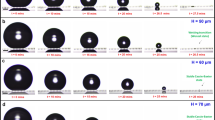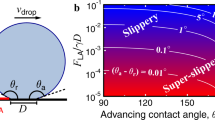Abstract
With a low surface energy, high apparent contact angle(>150°) and low sliding angle(<5°), superhydrophobic surface has recently been attracting a great deal of attention. The true factor determining the sliding angle still remains unclear. In this paper, various superhydrophobic silicon surfaces with pillars are fabricated by photolithography and hydrophobized with octadecyltrichlorosilane (OTS). Relations between sliding angles and micro-structured surfaces are being investigated in detail with 10 mg water droplets in C-B state and mixed state. Experimental pictures and data show that the sliding angle is independent of pillar heights from 20 to 80 µm, increasing the space between pillars causes decrease in sliding angle, and increasing the side lengths of pillars causes increase in sliding angle. Moreover, the sliding angle is irrelevant to the state of interfacial contact area of water-solid and lower contact line. It is concluded that the sliding angle of water droplet on the micro-structured surface is merely determined by the upper contact line.
Similar content being viewed by others
References
Suh K Y, Jon S C. Control over wettability of polyethylene glycol surfaces using capillary lithography. Langmuir, 2005, 21 (15): 6836–6841
Fan J G, Tang X J, Zhao Y P. Water contact angles of vertically aligned si nanorod arrays. Nanotechnologu, 2004, 15: 501–504
Yoshimitsu Z, Nakajima A, Watanabe T, et al. Effects of surface structure on the hydrophobicity and sliding behavior of water droplets. Langmuir, 2002, 18(15): 5818–5822
Tas N R, Mela P, Kramer T, et al. Capillarity induced negative pressure of water plugs in nanochannels. Nano Lett, 2003, 3: 1537–1540
Zhai Lei, Berg M C. Patterned superhydrophobic surfaces: toward a synthetic mimic of the namib desert beetle. Cohen Nano Lett, 2006 (6): 1213–1217
Murase H. Proceedings of the Fifth Interface Meeting of the Science Council of Japan, Tokyo, 1998 (in Japanese)
Murase H, Nanishi K, Kogure H, et al. J Interactions between heterogeneous surfaces of polymers and water. Appl Polym Sci, 1994, 54(13): 2051–2062
Reiner F, Wilhelm B, Christoph N, et al. Wetting and self-cleaning properties of artificial superhydrophobic surfaces. Langmuir, 2005, 21: 956–961
Frenkel Y Zh Eksp. Behaviour of liquid droplets on the surface of a solid. Teor Fiz, 1948
Furmidge C G L. Studies at phase interfaces I. The sliding of liquid drops on solid surfaces and a theory for spray retention. Journal of Coll Sci, 1962, 17(4): 309–324
Pere R, Joaquim F. Equilibrium of drops on inclined hydrophilic surfaces. Phys Rev, E 64, 011601 (2001)
Robert W. Resistance if solid surfaces to wetting by water. Ind Eng Chem, 1936, 28(8): 988–994
Cassie A B D, Baxter S. Wetability of porous surfaces. Faraday Soc, 1944, 40: 546–551
Yu Y. Mechanics study of surfacial microstucture and wetting properties. Doctor dissertation (in Chinese). Beijing: Tsinghua University, 2007: 30–33
Masashi M, Akira N, Akira F, et al. Effects of the surface roughness on sliding angles of water droplets on superhydrophobic surfaces. Langmuir, 2000, 16: 5754–5760
Gao L, Thomas J M. Comment on how Wenzel and Cassie were wrong by Gao and McCarthy. Langmuir, 2007, 23: 3762–3765
Zhu L, Feng Y Y, Ye X Y, et al. The 13th International Conference on Solid-State Sensors, Actuators and Microsystems, Seoul, June 5–9, 2005
Oner D, McCarthy T J. Ultrahydrophobic surfaces. Effects of topography length scakes on wetability. Langmuir, 2000,16: 7777–7782
Author information
Authors and Affiliations
Corresponding author
Additional information
Supported by the National Natural Science Foundation of China (Grant Nos. 10672089 and 10872106)
About this article
Cite this article
Yang, C., Hao, P. & He, F. Effect of upper contact line on sliding behavior of water droplet on superhydrophobic surface. Chin. Sci. Bull. 54, 727–731 (2009). https://doi.org/10.1007/s11434-009-0029-2
Received:
Accepted:
Published:
Issue Date:
DOI: https://doi.org/10.1007/s11434-009-0029-2




